A food chain describes the relationship between organisms in an ecosystem, showing the flow of energy and nutrients. It starts with producers, such as plants or algae, which convert sunlight into food through photosynthesis. Primary consumers, also known as herbivores, feed on the producers and are in turn eaten by secondary consumers, which can be carnivores or omnivores. This continues with tertiary consumers and can include apex predators. Decomposers play an important role in breaking down dead organisms and organic waste, returning nutrients to the environment. There are different types of food chains, including aquatic and terrestrial food chains.
Key Takeaways:
- Food chains show the flow of energy and nutrients in an ecosystem.
- Producers, such as plants or algae, convert sunlight into food through photosynthesis.
- Primary consumers are herbivores that feed on the producers.
- Secondary consumers can be carnivores or omnivores that feed on primary consumers.
- Decomposers break down dead organisms and organic waste, returning nutrients to the environment.
Trophic Levels in Food Chains
Organisms in food chains are organized into different trophic levels, each representing a position in the chain based on their feeding habits and energy source. Understanding the concept of trophic levels is essential for comprehending the flow of energy and nutrients within an ecosystem.
The first trophic level consists of autotrophs, also known as producers. These organisms, such as plants and algae, have the unique ability to produce their own food through photosynthesis. They convert energy from the sun into organic compounds, serving as the foundation of the food chain.
Primary consumers, or herbivores, make up the second trophic level. These organisms obtain their energy by feeding on autotrophs. Examples of primary consumers include deer, rabbits, and grasshoppers, which consume plants as their main food source.
The third trophic level comprises secondary consumers, which are organisms that feed on primary consumers. They can be carnivores or omnivores, depending on their diet. Examples of secondary consumers include predators like lions, hawks, and snakes, which consume herbivores as their primary source of energy.
At the top of the food chain, we find tertiary consumers. These organisms occupy the fourth trophic level and feed on secondary consumers. They are often apex predators and play a crucial role in regulating the population of lower trophic levels. Examples of tertiary consumers include wolves, bears, and eagles.
The organization of trophic levels helps illustrate the flow of energy and nutrients in a food chain. The chain can include additional trophic levels depending on the complexity of the ecosystem and the presence of other consumers. Each trophic level is interconnected and dependent on the one below it for energy and resources.
The Energy Pyramid
An energy pyramid is a graphical representation of trophic levels in a food chain, depicting the decreasing amount of energy available at each level. The pyramid shape reflects the fact that energy is lost as heat and metabolic processes move up the trophic levels.
“Trophic levels in a food chain represent the energy hierarchy within an ecosystem, showcasing the transfer of energy from producers to consumers and the subsequent decrease in available energy at each level.”
– Ecologist Dr. Jane Williams
As shown in the energy pyramid, the amount of energy available to primary consumers is greater than that available to the secondary consumers, and so on. This decrease in energy transfer efficiency limits the number of trophic levels an ecosystem can sustain.
Understanding trophic levels in food chains is crucial for comprehending the dynamics of ecosystems and the interdependence of organisms within them. It provides valuable insights into how energy flows, species interact, and ecosystem stability is maintained.
The Role of Decomposers in Food Chains
Decomposers play a crucial role in food chains by breaking down dead organisms and organic waste. They are essential for the recycling of nutrients and the continuation of the cycle of life. The two main groups of decomposers are bacteria and fungi.
Bacteria: Bacteria are microscopic organisms that are present everywhere in the environment. They play a significant role in decomposing dead organisms and organic matter. Bacteria feed on the remains of plants and animals, breaking them down into simpler compounds. Through this process, they convert complex organic matter into inorganic nutrients that can be used by other organisms.
Fungi: Fungi are another group of decomposers that are known for their ability to break down organic material. They obtain their nutrients by secreting enzymes that can break down complex molecules like cellulose and lignin, which are found in plant tissues. Fungi play a crucial role in decomposing plant matter, such as fallen leaves and wood debris.
Detritivores, such as scavengers and dung beetles, are organisms that consume nonliving plant and animal remains. They aid in the decomposition process by breaking down larger pieces of dead organisms into smaller particles that can be easily consumed by bacteria and fungi.
“Decomposers are nature’s recyclers. They break down dead organisms, returning nutrients to the environment and allowing new life to emerge.”
By breaking down dead organisms and organic waste, decomposers convert organic material into inorganic nutrients that enrich the soil or ocean. These nutrients are then utilized by autotrophs, such as plants and algae, to begin new food chains.
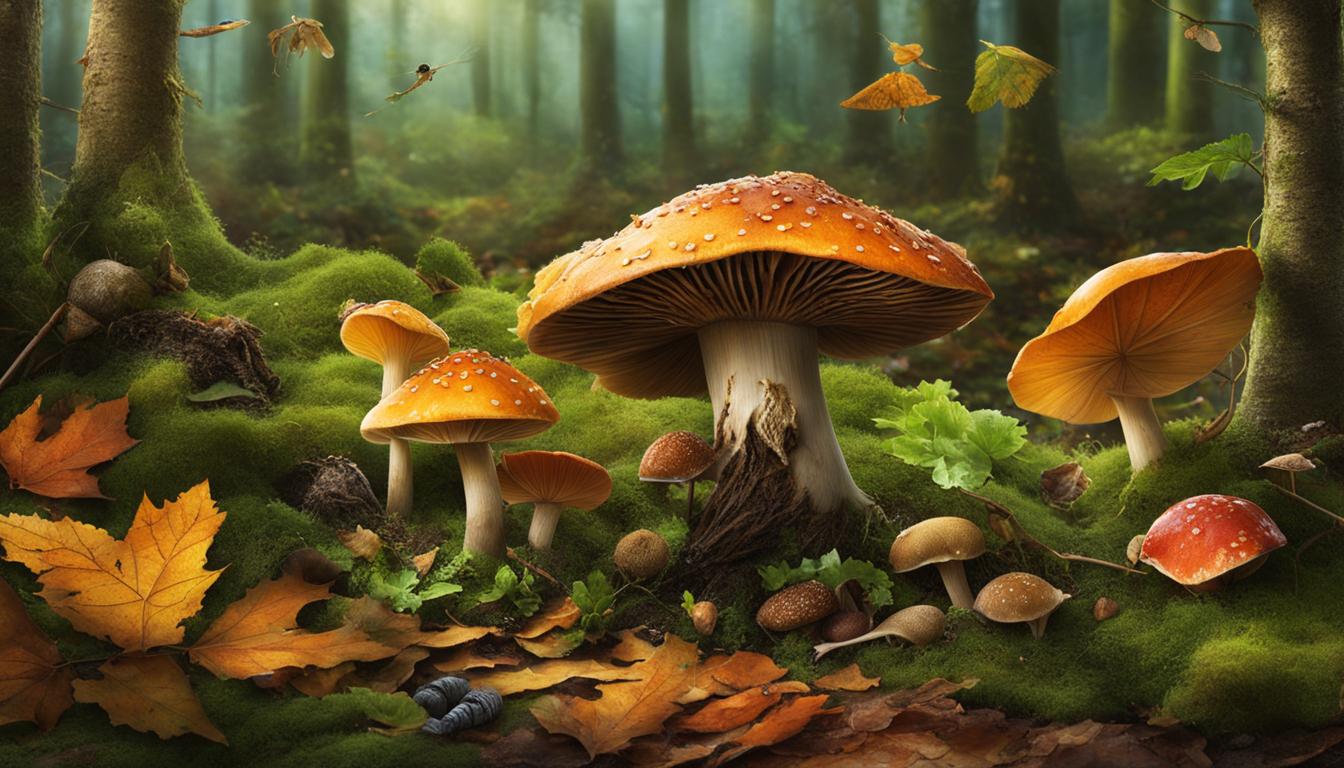
Overall, the role of decomposers in food chains is crucial for maintaining the balance of ecosystems and ensuring the efficient recycling of nutrients. Without decomposers, organic matter would accumulate, and nutrients would be trapped, leading to a decline in ecosystem health. Bacteria, fungi, and detritivores work together to complete the cycle of life and enable the continuation of food chains.
Energy Flow in Food Chains
Energy is the life force that sustains all living organisms in an ecosystem. In food chains, energy flows from one organism to another, driving the cycle of life. Let’s uncover the journey of energy within food chains and understand how it supports the survival and balance of ecosystems.
The sun serves as the primary source of energy in food chains. Producers, such as plants or algae, harness the sun’s energy through the process of photosynthesis. They convert sunlight into food energy, storing it in their tissues. This energy is then passed on to the next level of consumers.
The primary consumers, also known as herbivores, are the first consumers in the food chain. They consume the producers, obtaining energy from the stored sunlight. Examples of primary consumers include rabbits, deer, and grasshoppers.
Secondary consumers come next, feeding on the primary consumers. They can be carnivores or omnivores. Carnivores solely consume meat, while omnivores have a mixed diet of plants and animals. Wolves, lions, and bears are examples of secondary consumers.
As energy continues to flow through the food chain, it reaches the tertiary consumers. These are predators that feed on other consumers, including secondary consumers. They occupy the top levels of the food chain and are crucial in regulating population sizes within an ecosystem. Apex predators, like sharks or eagles, are examples of tertiary consumers.
“Energy flows from the sun to producers, from producers to consumers, and from one level of consumers to the next.”
It’s important to note that not all energy from one trophic level is transferred to the next. With each transfer, some energy is lost as heat. This loss of energy is a natural inefficiency in energy conversion. However, the remaining energy is vital for the survival and functioning of organisms in higher trophic levels.
The flow of energy in food chains is essential for sustaining life in ecosystems. It ensures a continuous supply of energy for producers to grow, reproduce, and provide food for consumers. Without this energy flow, the delicate balance of ecosystems would be disrupted, affecting the survival of species and the overall health of the environment.
| Trophic Level | Organisms | Examples |
|---|---|---|
| Producers | Plants, Algae | Grass, Seaweed |
| Primary Consumers | Herbivores | Rabbits, Deer |
| Secondary Consumers | Carnivores, Omnivores | Wolves, Lions |
| Tertiary Consumers | Top Predators | Sharks, Eagles |
“Energy flows from producers to primary consumers, then to secondary consumers, and finally to tertiary consumers.”
Understanding the energy flow in food chains is essential for comprehending the interdependence of organisms within ecosystems. It highlights the intricate relationships and dependencies that exist between producers and consumers. By maintaining a healthy energy flow, we can ensure the stability and sustainability of ecosystems for future generations.
Aquatic Food Chains
Aquatic ecosystems are home to diverse food chains that support marine life. These food chains are unique to the marine environment and play a crucial role in maintaining the balance of underwater ecosystems. Let’s explore how aquatic food chains operate, starting with the primary producers – phytoplankton.
“Phytoplankton, the tiny photosynthetic organisms, form the basis of the aquatic food chain.” Just like plants on land, phytoplankton use sunlight to produce energy through photosynthesis. They are abundant in marine environments and are responsible for converting sunlight into food energy. Phytoplankton are found near the ocean’s surface, where sunlight can penetrate the water.
“Zooplankton, the small animals, play a vital role in the aquatic food chain by feeding on phytoplankton.” Zooplankton are microscopic or small invertebrates that drift in the water column. They include copepods, krill, and small jellyfish. Zooplankton consume phytoplankton as their primary source of food.
As the food chain progresses, larger marine organisms come into play. “Fish, for example, feed on zooplankton as their source of energy.” Fish play an essential role in the aquatic food chain as secondary consumers. They consume zooplankton to meet their energy requirements. Some fish species, like anchovies or herring, have diets primarily composed of zooplankton.
At the top of the aquatic food chain are apex predators such as sharks or whales. These marine organisms “feed on smaller fish and maintain the balance of the marine ecosystem.” Apex predators are at the highest trophic level in the food chain and play a crucial role in regulating populations below them.
Here is an overview of the aquatic food chain:
| Organism | Role |
|---|---|
| Phytoplankton | Primary producers – convert sunlight into food energy through photosynthesis |
| Zooplankton | Primary consumers – feed on phytoplankton |
| Fish | Secondary consumers – feed on zooplankton |
| Apex predators (e.g., sharks, whales) | Top predators – feed on smaller fish |
As we can see, aquatic food chains are complex systems that involve different organisms at various trophic levels. These intricate relationships support the diverse marine life found in our oceans.
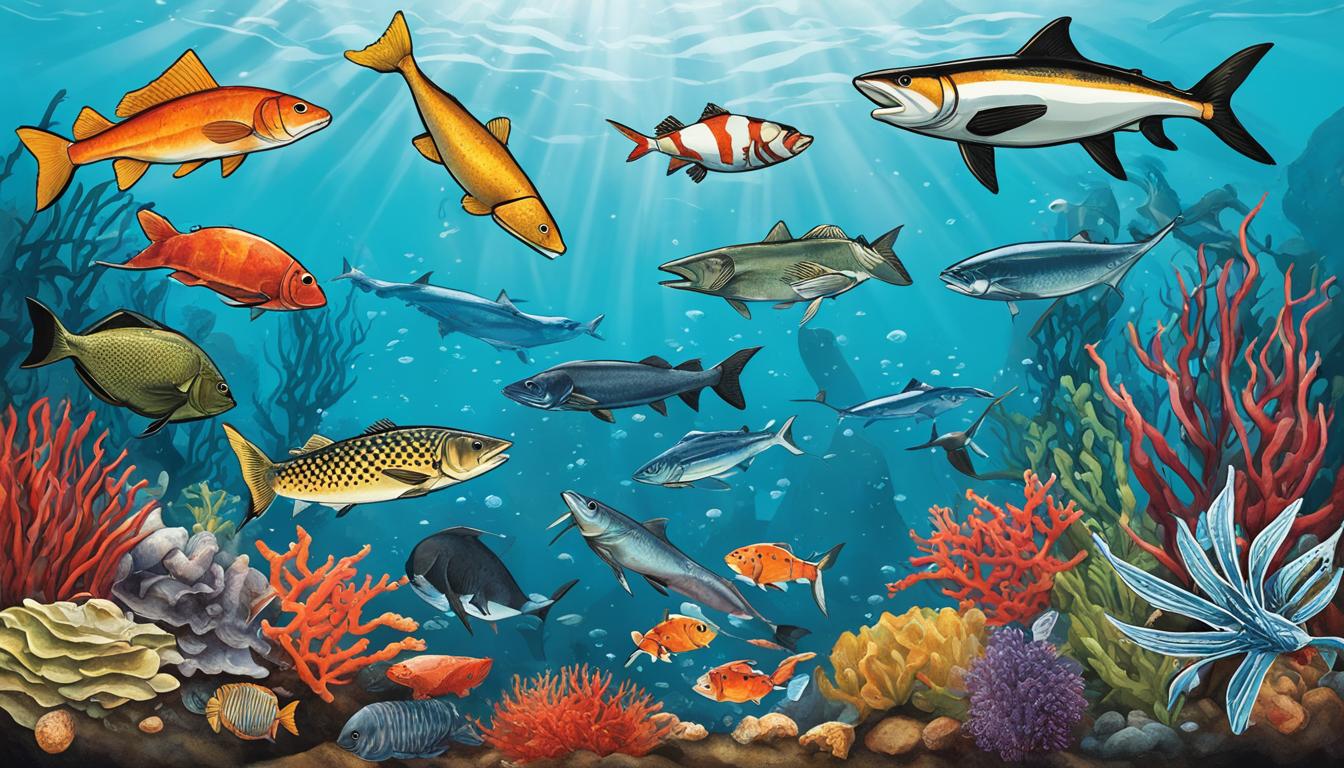
Understanding aquatic food chains is crucial for the conservation and management of marine ecosystems. By recognizing the importance of phytoplankton, zooplankton, and apex predators, we can work towards ensuring the health and sustainability of our precious ocean environments.
Terrestrial Food Chains
In terrestrial ecosystems, various organisms form interconnected food chains that sustain life and maintain ecosystem balance. Let’s explore the different trophic levels and the roles they play in these fascinating ecological webs.
Herbivores: Primary Consumers
Herbivores are the primary consumers in terrestrial food chains, feeding directly on plants for their nutritional needs. Examples of herbivores include deer, rabbits, and grasshoppers. They play a crucial role in controlling plant populations and nutrient cycling within the ecosystem.
Carnivores: Secondary Consumers
Carnivores occupy the secondary consumer level in terrestrial food chains by preying on herbivores. These include animals like wolves, lions, and foxes. Carnivores have adaptations that allow them to catch and consume other animals for their energy requirements.
Omnivores: Versatile Consumers
Omnivores, such as humans and bears, have a diverse diet that includes both plant and animal matter. They occupy different trophic levels depending on their food sources. Omnivores play a unique role in terrestrial food chains by interacting with both the herbivore and carnivore trophic levels.
Apex Predators: The Top of the Food Chain
At the top of the terrestrial food chain are apex predators, which have no natural predators themselves. These predators, like lions, tigers, and crocodiles, play a critical role in maintaining population levels within the ecosystem and regulating species interactions.
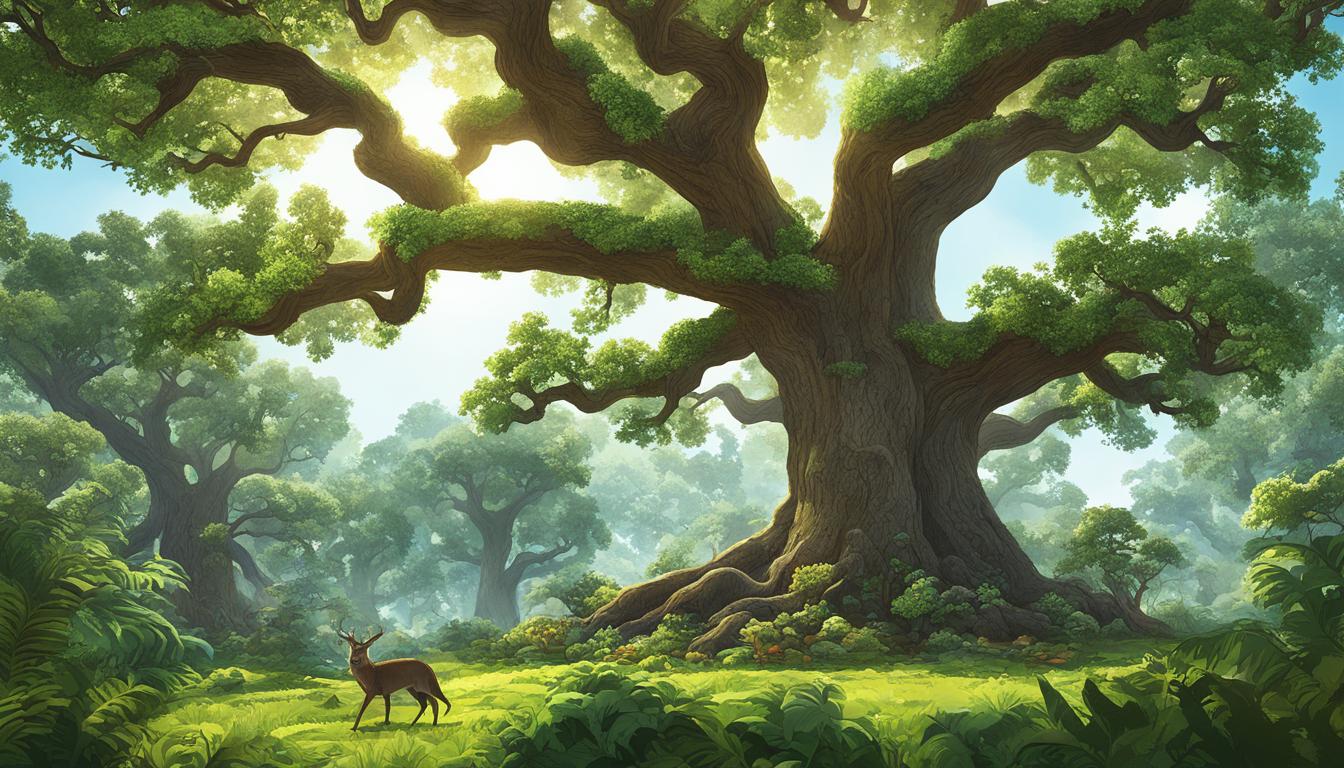
The image above illustrates the relationships and energy flow within terrestrial food chains. It visually depicts the trophic levels and the transfer of energy from one level to another, highlighting the importance of each organism’s role in maintaining ecosystem balance.
Terrestrial food chains are complex systems of interdependence, where herbivores, carnivores, omnivores, and apex predators play vital roles in sustaining life. Understanding these food chains helps us comprehend the delicate balance of nature and the significance of preserving ecosystem integrity.
Examples of Food Chains
Food chains are prevalent in various habitats, illustrating the interconnectedness of organisms and the transfer of energy. Here are a few examples of food chains in different ecosystems:
Forest Ecosystem:
A forest ecosystem harbors a diverse range of organisms, each playing a unique role in the food chain. A typical forest food chain can involve:
- Producers (e.g., plants)
- Primary consumers (e.g., herbivores like deer)
- Secondary consumers (e.g., predators like wolves)
- Apex predators (e.g., bears or cougars)
This example showcases the flow of energy as plants are consumed by herbivores, which are then preyed upon by predators, ultimately sustaining the apex predators at the top of the chain.
Ocean Ecosystem:
The ocean is a vast ecosystem with unique food chains supporting diverse marine life. In an ocean food chain, we can observe the following:
- Producers (e.g., phytoplankton)
- Primary consumers (e.g., zooplankton)
- Secondary consumers (e.g., various fish species)
- Apex predators (e.g., sharks)
In this example, the food chain begins with phytoplankton, which are consumed by zooplankton, serving as the primary consumers. The energy is then transferred through various fish species, culminating in apex predators like sharks.

These examples provide a glimpse into the intricate web of life in different ecosystems. Each food chain represents a unique scenario, showcasing the interdependence and energy flow among organisms. By studying these examples, we gain a deeper understanding of the delicate balance within ecosystems and the significance of food chains in sustaining life.
The Complexity of Food Webs
While food chains provide a simplified view of energy transfer, the interconnected nature of food chains within an ecosystem forms a food web. A food web is a more complex representation of the interactions between different organisms in an ecosystem. It shows the pathways of energy flow that occur when a single organism is consumed by multiple predators or consumes multiple organisms. Food webs provide a more accurate representation of energy flow and species interactions in an ecosystem.
Food web examples:
- A forest ecosystem:
- Producers: plants
- Primary consumers: herbivores like deer
- Secondary consumers: predators like wolves
- Apex predators: bears or cougars
- An ocean ecosystem:
- Producers: phytoplankton
- Primary consumers: zooplankton
- Secondary consumers: various fish species
- Apex predators: sharks
Interconnected food chains within a food web create a complex network of relationships, reflecting the diverse interactions and energy flow in an ecosystem.
“Interconnected food chains in a food web reflect the complex relationships and energy flow in an ecosystem.” – Anonymous
Energy Flow in Food Webs
Energy transfer in food webs follows the same pattern as energy flow in food chains. Producers capture energy from the sun and convert it into food energy through photosynthesis. This energy is then transferred to primary consumers, which consume the producers. Secondary consumers obtain energy by consuming the primary consumers, and so on.
However, the complexity of food webs allows for more diverse energy pathways. An organism can be consumed by multiple predators or consume multiple organisms, leading to a more intricate flow of energy. This interconnectedness ensures that energy is distributed efficiently throughout the ecosystem, supporting the survival of various species.
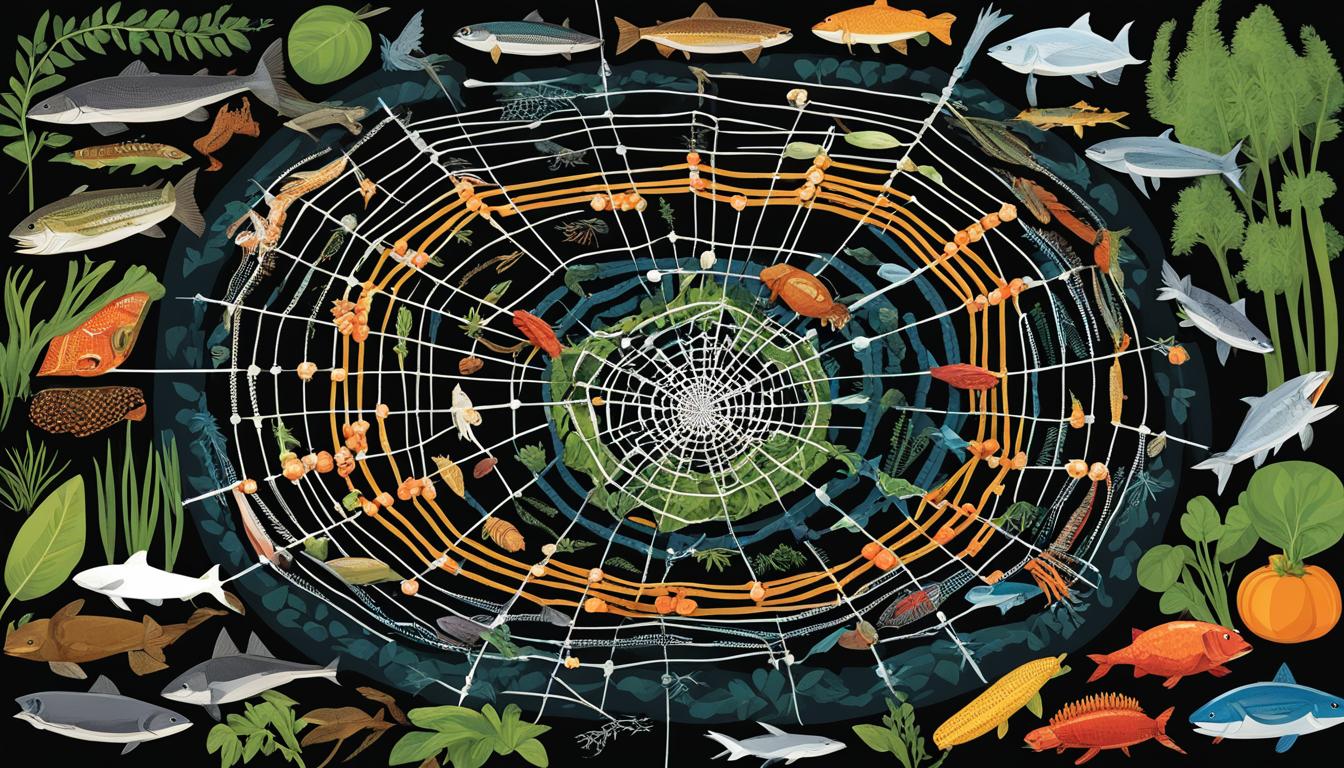
The table below demonstrates an example of interconnected food chains in a forest ecosystem:
| Organism | Trophic Level | Primary Consumers | Secondary Consumers | Tertiary Consumers | Apex Predators |
|---|---|---|---|---|---|
| Plants | Producers | Deer | Wolves | – | Bears or Cougars |
| Deer | Primary Consumers | – | Wolves | – | Bears or Cougars |
| Wolves | Secondary Consumers | – | – | – | Bears or Cougars |
| Bears or Cougars | Apex Predators | – | – | – | – |
Importance of Understanding Food Chains
Understanding food chains is vital for comprehending the intricate relationships and dependencies within an ecosystem. By gaining knowledge of how energy flows from one organism to another, we can begin to truly appreciate the delicate balance that exists in nature.
Food chains provide us with a framework to understand the role each organism plays in the ecosystem. From producers to consumers and decomposers, every species has its place and specific function. Knowing where an organism falls within the food chain helps reveal its interactions with other species and the impact it has on the overall ecosystem.
“The interconnectedness of species within food chains highlights the complexity of ecosystem dynamics. Each organism, whether large or small, contributes to the intricate web of life.”
Understanding food chains also allows us to recognize the potential consequences of disruptions. For example, the decline of a top predator can lead to an increase in the population of its prey, which may have a cascading effect on other species. Similarly, the introduction of non-native species can disrupt established food chains and cause imbalances in the ecosystem.
By studying and comprehending food chains, we can better manage and conserve ecosystems. It highlights the importance of maintaining a balanced and stable environment to ensure the survival of all species. As we continue to face environmental challenges, understanding food chains becomes increasingly crucial in preserving biodiversity and ecosystem health.
Why Is Understanding Energy Flow Essential?
At the core of food chains lies the vital concept of energy flow. Energy flows from one trophic level to another, driving the functioning and sustainability of ecosystems. It is the fuel that powers the intricate web of life.
The sun acts as the primary source of energy, providing sunlight that is captured by producers, such as plants, through photosynthesis. This energy is then transferred from one level to the next as organisms consume each other. However, it’s important to note that energy transfer between trophic levels is never 100% efficient. Some energy is lost as heat at each level, limiting the amount of energy available to higher trophic levels.
Understanding energy flow allows us to gauge the efficiency of nutrient cycling within food chains. It provides insights into the stability and resilience of ecosystems. High-energy transfer efficiency ensures a smooth flow of energy and supports a diversity of species throughout the food chain. On the other hand, low-energy transfer efficiency can disrupt the balance and lead to the decline or extinction of certain species.
Recognizing the significance of energy flow helps us identify potential vulnerabilities within ecosystems and develop strategies for their conservation. By focusing on efficient energy transfer and nurturing balanced food chains, we can promote the health and longevity of ecosystems for the benefit of all species.
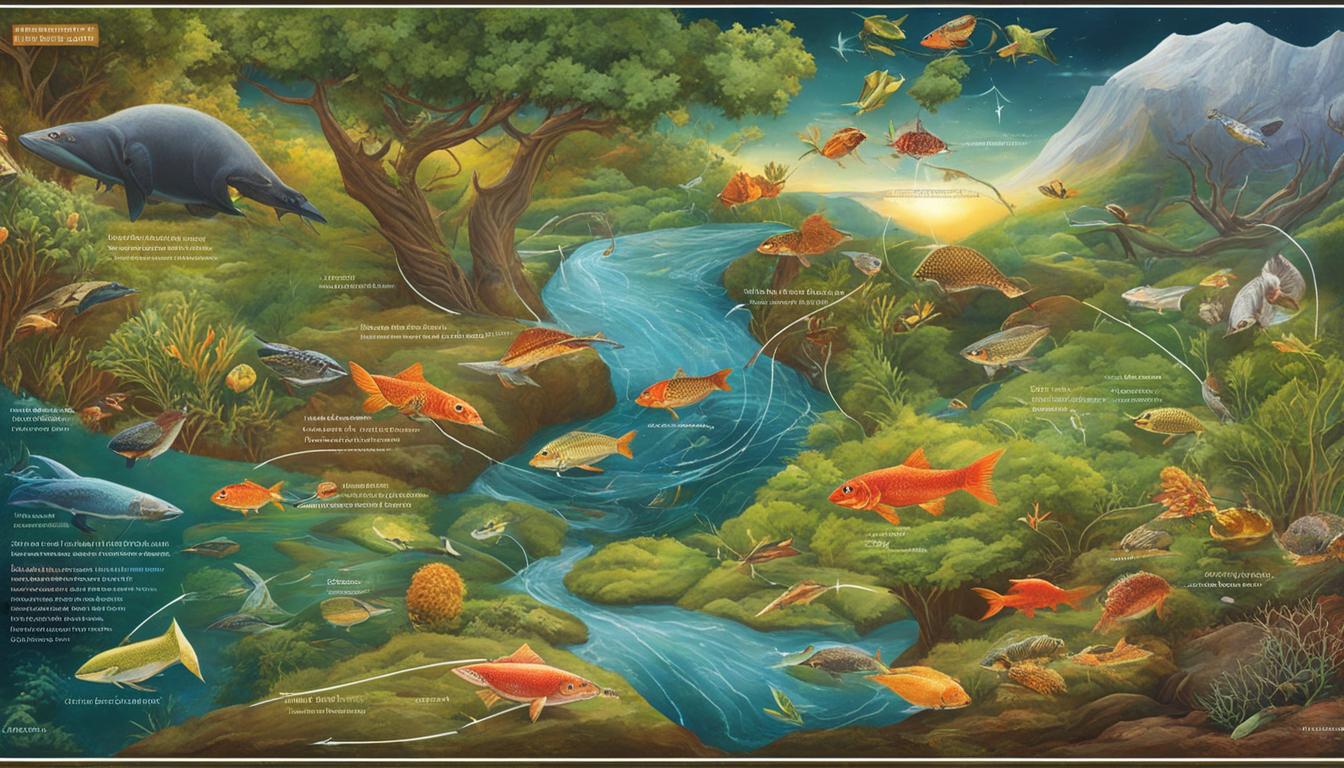
Understanding food chains and energy flow is crucial in building a sustainable future. It allows us to make informed decisions and implement conservation practices that ensure the survival of all species and the maintenance of ecosystem balance. By recognizing our role and responsibility within food chains, we can promote the well-being of our planet and secure a harmonious coexistence with nature.
The Significance of Energy Flow in Food Chains
Energy flow in food chains is crucial for maintaining nutrient cycling and ecosystem stability. It plays a vital role in ensuring the balance and sustainability of an ecosystem. The efficiency of energy transfer from one trophic level to the next is a determining factor in the overall functioning of the ecosystem.
In an ecosystem, energy is transferred through various trophic levels starting from producers, such as plants or algae, to consumers, including herbivores, carnivores, and omnivores. Each trophic level depends on the energy provided by the previous level, creating a flow of energy through the food chain.
The efficient transfer of energy allows for optimal nutrient cycling within the ecosystem. As organisms consume food, they extract nutrients and energy from it. These nutrients are then released back into the environment through processes like decomposition and excretion, contributing to the cycling of essential elements like carbon, nitrogen, and phosphorus.
The transfer of energy in food chains also directly impacts ecosystem stability. High-energy transfer efficiency ensures that energy is effectively passed along to support the growth and survival of organisms in higher trophic levels. This sustains the overall balance and productivity of the ecosystem.
Conversely, low-energy transfer efficiency can disrupt the balance within the food chain. When energy is not efficiently transferred, it can lead to imbalances and instability. For example, if there is a lack of energy available to support the higher trophic levels, populations of predators may decline, causing an increase in the populations of their prey. This can result in overgrazing or depletion of certain populations, affecting the overall health and stability of the ecosystem.
Understanding the mechanisms of energy flow in food chains helps us identify potential vulnerabilities and manage ecosystems effectively. By monitoring and ensuring the efficient transfer of energy, we can promote the balance and stability of ecosystems, contributing to their long-term health and sustainability.
Table: Comparison of Energy Transfer Efficiency in Different Ecosystems
| Food Chain Type | Energy Transfer Efficiency |
|---|---|
| Aquatic Food Chains | High |
| Terrestrial Food Chains | Moderate |
| Decomposer Food Chains | Low |
As shown in the table above, the energy transfer efficiency varies across different ecosystem types. Aquatic food chains tend to have higher energy transfer efficiency due to the abundance of primary producers, like phytoplankton, that support the trophic levels. Terrestrial food chains have a moderate energy transfer efficiency, as the availability of energy is comparatively lower than in aquatic ecosystems. Decomposer food chains, which involve organisms like bacteria and fungi, have lower energy transfer efficiency as they rely on the decomposition of organic matter.
Understanding the significance of energy flow in food chains is essential for maintaining the health and balance of ecosystems. By promoting efficient energy transfer, we can ensure nutrient cycling, support diverse species interactions, and contribute to the overall stability of ecosystems.

The Relationship Between Humans and Food Chains
As humans, we play a significant role in food chains, acting as consumers within ecosystems. Depending on our diet, we can be primary consumers if we consume plants directly or secondary consumers if we consume animals that eat plants. Our choices in food production and consumption have the power to impact food chains and ecosystems in profound ways.
Humans in Food Chains
When we consume plants or animals, we become part of the food chain. As primary consumers, we rely on the energy stored in plants, such as fruits, vegetables, and grains. When we choose to consume the meat of herbivorous animals, we become secondary consumers. This interconnectedness highlights our role as both participants and influencers in food chains.
Human Impacts on Food Chains
The choices we make in food production and consumption can have significant consequences for food chains and ecosystems. Unsustainable agricultural practices, such as the overuse of chemical fertilizers and pesticides, can disrupt the natural balance of food chains by negatively affecting the populations of organisms at various trophic levels. Additionally, activities like deforestation and habitat destruction can lead to the loss of crucial habitats and disrupt food chains.
Sustainable Food Production
To maintain the balance and resilience of food chains, we must adopt sustainable food production practices. Sustainable agriculture focuses on minimizing the use of synthetic chemicals and adopting practices that promote soil health and biodiversity. Responsible fishing techniques, such as implementing catch limits and avoiding destructive fishing practices, can help protect marine food chains. Additionally, reducing food waste can play a significant role in preserving food chains by ensuring that valuable resources are maximized.
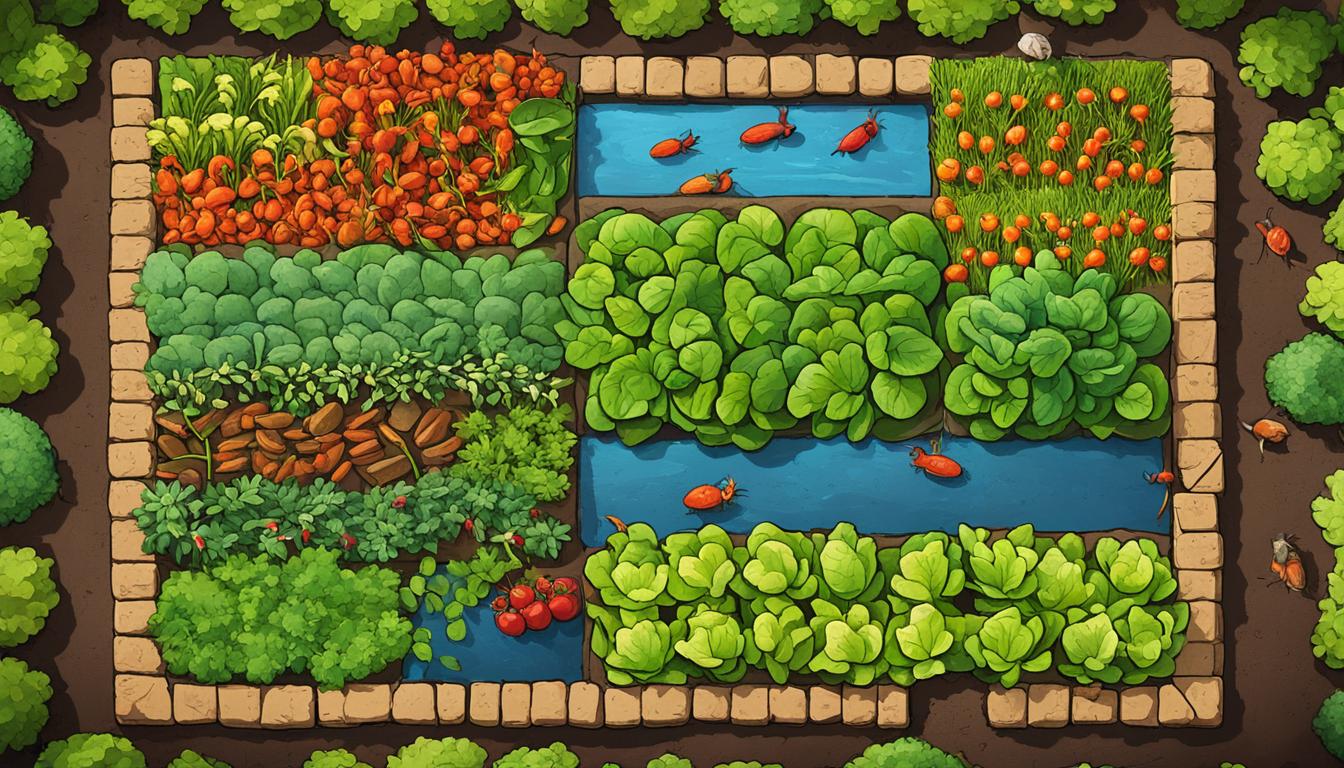
“Our choices in food production and consumption have the power to impact food chains and ecosystems in profound ways.”
Recognizing our role as consumers in food chains, we have the responsibility to act responsibly and prioritize sustainable food production. By implementing sustainable practices in both agriculture and fishing, we can contribute to the health and resilience of food chains. Small changes, such as supporting local and organic producers, reducing meat consumption, and properly recycling food waste, can have a positive cumulative effect on the overall sustainability of food chains.
Conclusion
Exploring the various types of food chains provides valuable insight into the complexity of ecosystems. Food chains are not just linear pathways but intricate networks that illustrate the flow of energy and nutrients between organisms. By understanding food chains, we gain a deeper understanding of the interdependence and relationships within an ecosystem.
Food chains allow us to comprehend the interactions between different species, from autotrophs to apex predators. They showcase the vital role of primary consumers, secondary consumers, and tertiary consumers in maintaining a balanced ecosystem. Furthermore, food chains emphasize the vital role of decomposers in breaking down dead organisms and returning essential nutrients back into the environment.
By recognizing the significance of food chains, we can make informed decisions to promote the health and sustainability of ecosystems. Understanding the energy flow and nutrient cycling in food chains helps us identify potential vulnerabilities and manage ecosystems effectively. We can address human impacts on food chains through sustainable food production practices, responsible consumption, and reducing food waste.
In conclusion, comprehending the intricacies of food chains is fundamental to preserving the delicate balance of Earth’s ecosystems. By acknowledging the interdependent nature of organisms and the flow of energy and nutrients, we can work towards creating a future where ecosystems thrive, species coexist harmoniously, and the planet remains healthy for generations to come.
FAQ
What is a food chain?
A food chain describes the relationship between organisms in an ecosystem, showing the flow of energy and nutrients. It starts with producers, such as plants or algae, which convert sunlight into food through photosynthesis.
What are trophic levels in food chains?
Organisms in food chains are organized into trophic levels. Autotrophs, also known as producers, make up the first trophic level and include plants and algae. Primary consumers, or herbivores, are organisms that eat the producers. The chain continues with secondary consumers, tertiary consumers, and apex predators.
What is the role of decomposers in food chains?
Decomposers play a crucial role in breaking down dead organisms and organic waste, returning nutrients to the environment. They include bacteria and fungi. Detritivores, such as scavengers and dung beetles, consume nonliving plant and animal remains before decomposers further break down the material.
How does energy flow in food chains?
Energy flows through food chains, starting with the sun as the primary source. Producers capture sunlight and convert it into food energy through photosynthesis. This energy is then transferred to primary consumers, secondary consumers, and so on. Each transfer of energy is not 100% efficient, with some energy lost as heat.
What are examples of aquatic food chains?
In marine environments, phytoplankton forms the base of the food chain. They are eaten by zooplankton, which are then consumed by larger marine organisms, such as fish, and ultimately, apex predators like sharks or whales.
What are examples of terrestrial food chains?
In terrestrial ecosystems, food chains can include herbivores like deer or rabbits as primary consumers, followed by carnivores like wolves as secondary consumers. At the top are apex predators, which have no natural predators and play a role in regulating populations within the ecosystem.
Can you provide examples of food chains?
In a forest ecosystem, a food chain could include plants as producers, herbivores like deer as primary consumers, predators like wolves as secondary consumers, and apex predators like bears or cougars. In an ocean ecosystem, the food chain could start with phytoplankton as producers, followed by zooplankton as primary consumers, various fish species as secondary consumers, and sharks as apex predators.
What is the complexity of food webs?
While food chains provide a simplified view of energy transfer, the interconnected nature of food chains within an ecosystem forms a food web. Food webs show the pathways of energy flow when a single organism is consumed by multiple predators or consumes multiple organisms, providing a more accurate representation of energy flow and species interactions.
Why is understanding food chains important?
Understanding food chains is vital for comprehending the relationships and dependencies within an ecosystem. It allows us to grasp how energy flows and the role each organism plays. Knowledge of food chains helps us understand the impact of disruptions and the importance of maintaining a balanced ecosystem.
What is the significance of energy flow in food chains?
Energy flow is critical for maintaining nutrient cycling and ecosystem stability. The efficiency of energy transfer determines the overall balance within the ecosystem. High-energy transfer efficiency sustains the ecosystem, while low-energy transfer efficiency can disrupt the balance and lead to instability.
What is the relationship between humans and food chains?
Humans play a significant role in food chains as consumers. Our choices in food production and consumption can impact food chains and ecosystems. Practices such as sustainable agriculture and responsible fishing can contribute to maintaining the balance and resilience of food chains.

